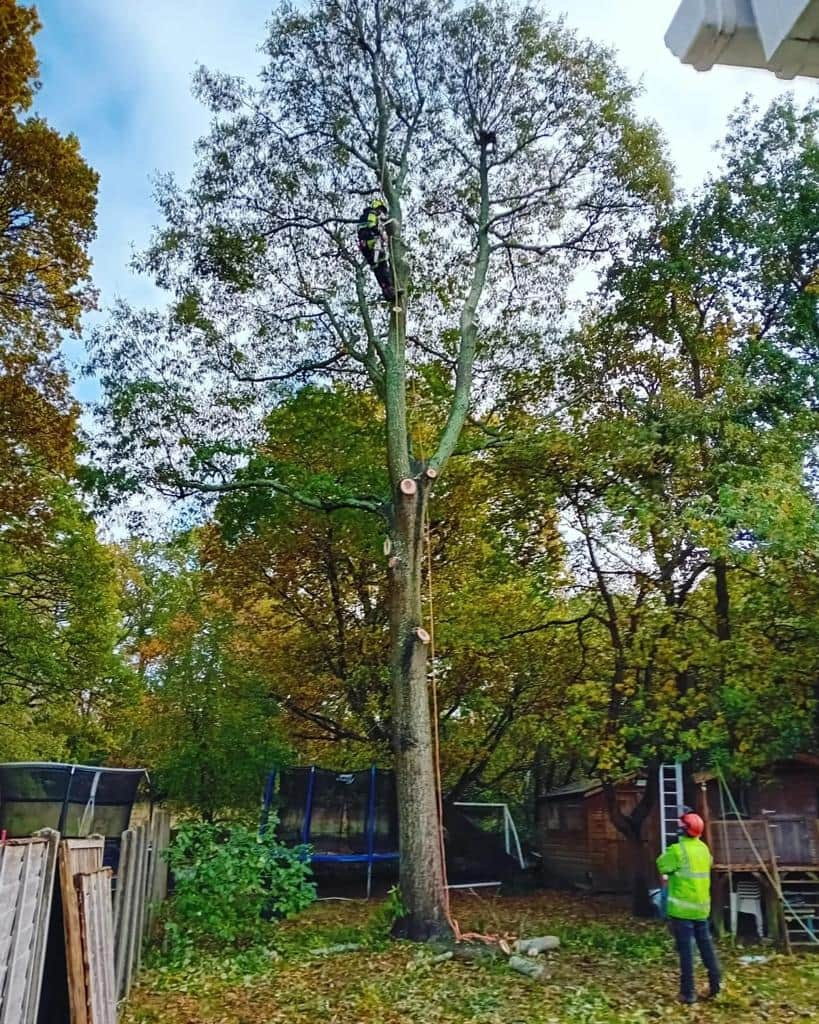Trees are vital to our landscapes, offering beauty, shelter, and ecological value. However, when a tree becomes structurally unstable or severely diseased, it can quickly turn from an asset to a serious hazard. Recognising the early warning signs that a tree may be at risk of collapse is essential for ensuring safety and preventing potential damage. At EM Tree Surgery Colesbourne, we provide professional assessments and felling services throughout Colesbourne, Gloucestershire, helping property owners identify when intervention is necessary to avoid accidents or property damage.
Understanding the Risks of Unstable Trees
A tree at risk of collapse poses significant dangers. High winds, heavy rain, or even the tree’s own weight can cause weakened structures to fail without warning. While some signs of decline are obvious, others can be subtle and easily overlooked. Regular inspection by professionals helps detect these issues early, but knowing what to look for yourself is equally important.
Common Warning Signs a Tree May Need Urgent Felling
1. Visible Leaning or Shifting
A leaning tree doesn’t always indicate a problem — some naturally grow at an angle — but if the lean is new or worsening, it could point to root instability or structural weakness.
- Sudden Lean: A recent change in angle, especially following storms or high winds, suggests compromised roots.
- Soil Movement: Cracking or lifting soil around the base of the tree can indicate that the root plate is shifting.
- Uneven Canopy Weight: Heavy growth on one side of the crown can create imbalance and increase the risk of toppling.
If a lean develops quickly or the ground around the trunk appears disturbed, it’s vital to have the tree inspected immediately.
2. Cracks or Splits in the Trunk
Structural cracks are a clear indicator of internal weakness. They can appear vertically or horizontally and often result from wind stress or internal decay.
- Deep Fissures: Large or expanding splits can cause the tree to break apart.
- Bark Separation: Areas where bark has lifted away may reveal decay beneath.
- Sound Changes: A hollow or dull sound when tapping the trunk may indicate internal rot.
At EM Tree Surgery Colesbourne, we use professional assessment techniques to determine the extent of the damage and whether felling is the safest solution.
3. Extensive Decay or Fungal Growth
Fungi growing on or around the base of the tree often signal decay inside the trunk or roots. While some species live harmlessly on the surface, others indicate serious internal decomposition.
- Mushrooms at the Base: Especially during autumn or damp periods, clusters of fungi can suggest root rot.
- Soft or Spongy Wood: The base of the trunk becoming soft to the touch shows decay has advanced.
- Hollow Sections: Cavities or holes in the trunk reduce the tree’s structural strength significantly.
Decay can spread silently within the wood, so visible fungi should always be treated as a warning sign.
4. Dead or Dying Branches
Deadwood can form naturally, but when large sections of the canopy show bare or lifeless branches, the tree may be in serious decline.
- Brittle Branches: Easily snapped branches suggest internal dryness or disease.
- No Leaf Growth: Sections of the canopy failing to produce leaves in spring indicate dieback.
- Falling Limbs: Frequent limb drop during calm weather shows internal weakness.
A tree shedding limbs regularly could collapse in full if left unchecked, particularly under high winds or heavy rainfall.
5. Root Damage or Instability
Roots anchor the tree and provide essential nutrients. If they are damaged or diseased, the entire structure becomes vulnerable to failure.
- Uprooted Roots: Exposed or lifted roots after storms are a serious warning.
- Excavation Damage: Construction work or trenching near the base can sever major roots, weakening support.
- Rot or Fungal Decay: Discolouration, soft patches, or foul odours near the base can indicate root rot.
Root damage is often invisible until it’s too late. Professional tree surgeons can assess underground stability using visual and manual checks before recommending felling.
6. Sudden Changes After Weather Events
Extreme weather, especially in Gloucestershire’s mixed climate, can reveal underlying issues. Heavy storms, snow, or long periods of rain may trigger collapse in already weakened trees.
- After Storms: Check for cracks, leaning, or hanging branches.
- After Prolonged Rain: Watch for ground movement or waterlogging around the trunk, as saturated soil can loosen root anchorage.
If the tree’s condition appears different following severe weather, it’s advisable to contact EM Tree Surgery Colesbourne for an urgent inspection.
7. Hollow or Cavernous Trunks
Hollow trunks may still support some trees for years, but once the hollow area extends too far through the core, the risk of collapse increases dramatically.
- Large Cavities: Open sections weaken the trunk’s load-bearing strength.
- Insect Infestation: Boring insects and woodworms accelerate internal decay.
- Bird or Animal Activity: Excessive nesting within cavities may indicate advanced hollowness.
When hollows reach more than one-third of the tree’s diameter, professional felling is often recommended to prevent unexpected failure.
8. Canopy Imbalance or Sparse Growth
An uneven or thinning canopy may suggest root or trunk problems below. If nutrients are not being distributed evenly, certain sections may die off, increasing imbalance and risk of toppling.
- Sparse Foliage: Indicates nutrient deficiencies or disease.
- Heavy Growth on One Side: Adds uneven weight, creating stress on weakened roots or trunk sections.
Monitoring these changes helps identify early structural instability.
Why Acting Quickly Matters
A tree showing these warning signs can deteriorate rapidly. What may seem stable one week could become hazardous the next, especially under wind or rainfall stress. Taking early action not only protects your property but also ensures the safety of anyone nearby.
At EM Tree Surgery Colesbourne, we specialise in assessing and safely removing trees that pose an immediate risk. Our experienced team evaluates each tree’s condition, stability, and proximity to structures to determine whether felling is necessary.
Preventative Measures to Reduce Risk
Even healthy trees benefit from regular maintenance to prevent future instability. Homeowners can reduce collapse risk through:
- Routine Inspections: Annual assessments detect decay or imbalance before they worsen.
- Crown Reduction or Pruning: Removes excess weight and improves wind resistance.
- Root Zone Protection: Avoid soil compaction and excavation near the base.
- Prompt Deadwood Removal: Prevents falling branches and reduces disease risk.
By taking a proactive approach, trees can remain strong and safe for many years.
Conclusion
Recognising the signs of a failing tree can prevent accidents, property damage, and environmental loss. Leaning trunks, decayed wood, fungal growth, and dead branches are all indicators that urgent assessment or felling may be required. For residents and landowners in Colesbourne, EM Tree Surgery Colesbourne provides professional expertise in identifying and safely managing high-risk trees. Acting early ensures your landscape remains both beautiful and secure for the long term.
Call us on: 01242 569 996
Click here to find out more about EM Tree Surgery Colesbourne
Click here to complete our contact form and see how we can help with your tree needs.

